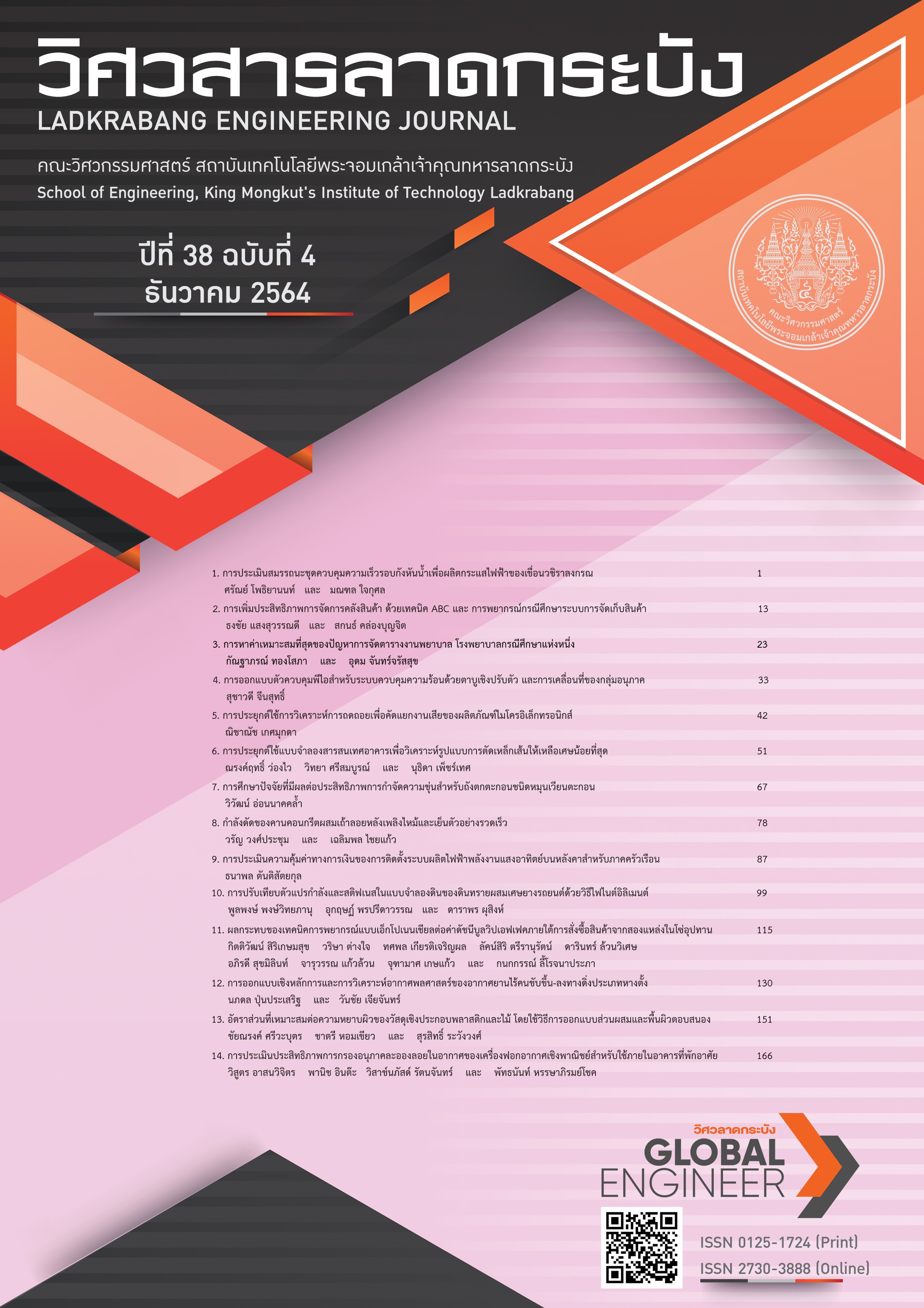Evaluation of the Filtration Efficiency of Aerosol Particles of the Commercial Air Purifiers for indoor use
Keywords:
Aerosol, PM2.5, PM10, Air PurifierAbstract
The aim of this paper is to evaluation of the filtration efficiency of aerosol particles of the commercial air purifiers for indoor use purifiers with different sizes and principles e.g., 4 electrostatic air purifiers and 1 HEPA filter air purifier. In this study, the filtration efficiency of aerosol particles of five commercial indoor air purifiers were tested by the ANSI/AHAM AC-1-2015 standard test method with the aerosol particle generators inside the 6 m × 6 m × 3 m test chamber. The real-time particle counter was used for measuring the number and mass concentrations of aerosol particles inside the test chamber within testing time of 120 min It was found from the experiment that the decrease in the mass concentration of the aerosol particles is proportional to the increase in testing time. Due to the longer testing time, room air that still retains suspended aerosol particles recirculates through the air purifier at a constant air volumetric flow rate of the purifier for the duration of the testing time. The maximum particle filtration efficiency in the case of combining particle natural decay of the A, B, C, D and E purifiers is about 61.30, 65.63, 81.73, 77.39 and 72.755 % at 120 min respectively, and the maximum particle filtration efficiency in the case of excluding particle natural decay of the A, B, C, D and E purifiers is about 13.19, 22.91, 59.02, 49.03 and 38.88 % at 120 min respectively. Finally, in this experiment, it was shown that the CADR values of A, B, C, D and E purifiers were about 4.47, 7.58, 24.36, 17.82 and 13.7 ft3/h, respectively.
References
COVID-19 situation report, Department of Disease Control, Oct. 24, 2020. [Online]. Available: https://covid19.ddc.moph. go.th/
D. Thepnuan, N. Yabueng, S. Chantara, T. prapamontol and Y. I. Tsai, “Simultaneous Determination of
Carcinogenic PAHs and Levoglucosan Bound to PM2.5 for Assessment of Health Risk and Pollution Sources during a Smoke Haze Period,” Chemosphere, vol. 257, 2020, doi: 10.1016/j.chemosphere.2020.127154.
P. Intra, Electrostatic aerosol measurement and control technology, Chula Press, Bangkok, Thailand, 2019.
WC. Hinds, Aerosol Technology, John Wiley & Sons, New York, USA, 1999.
A. Fushimi, S. Hasegawa, K. Takahashi, Y. Fujitani, K. Tanabe and S. Kobayashi, “Atmospheric Fate of Nuclei-mode Particles Estimated from the Number Concentrations and Chemical Composition of Particles Measured at Roadside and Background Sites,” Atmospheric Environment, vol.42, no.5, pp.949–959, 2008, doi:10.1016/j.atmosenv.2007.10.019.
P. Intra and T. Siri-achawawath, “Development of an Online Particulate Monitoring System for Measurement of the Mass and Number Concentrations and Size Distributions of Ambient PM10, PM2.5 and sub-400 nm Particles,” Songklanakarin Journal of Science and Technology, vol.41, no.6, pp.1339–1347, 2019.
U. Vinitketkumnuen, T. Chewonarin and N. Chunram, “Oxidative damage to DNA from alveolar lung cell lines by air-borne particulate matter PM 2.5 & PM 10 extractable from Chiang Mai and Lumphun,” The Thailand Research Fund, Bangkok, Thailand, final Rep. 2007.
A. Srivastava, “COVID-19 and Air pollution and Meteorology-an Intricate Relationship: A Review,” Chemosphere, vol.263, 2021, doi: 10.1016/j.chemo sphere.2020.128297.
When do I need to replace the air filter, Khaosod Online, Jan. 3, 2020 [Online] Available: https://www.khaosod.co.th/pr-news/news_3313589,
K. Willeke and P.A. Baron, Aerosol Measurement: Principles, Techniques, and Applications, John Wiley & Sons, New York, USA, 1993.
H. J. White, “Particle charging in electrostatic precipitation,” Transactions of the American Institute of Electrical Engineers , vol. 70, no. 2, pp. 1186–1191, 1951, doi: 10.1109/T-AIEE.1951.5060545.
Ministerial regulations Issue 55. (2000). Building Control Act 1979. Available: https:// download.asa.or.th/03media/04law/cba/mr/mr43-55-upd68.pdf
K. Tintachart, W. Norkaew, A. Yawootti and P. Intra, “Modification and Field Testing of an Indoor Electrostatic Air Purifier,” Journal of KMUTNB, vol. 27, no.1, pp. 31–46, 2017.
Method for Measuring Performance of Portable Household Electric Room Air Cleaners, ANSI/AHAM AC-1-2006, Association of Home Appliance Manufacturers Washington, D.C., USA, 2006.
H. Kim, B. Han, C. G. Woo, Y. Kim, G. Lim and W. G. Shin, “Air Cleaning Performance of a Novel Electrostatic Air Purifier Using an Activated Carbon Fiber Filter for Passenger Cars,” IEEE Transactions on Industry Applications, vol. 53, no. 6, pp. 5867–5874, 2017, doi: 10.1109/TIA.2017.2745499.
Downloads
Published
How to Cite
Issue
Section
License
Copyright (c) 2021 Faculty of Engineering, King Mongkut’s Institute of Technology Ladkrabang

This work is licensed under a Creative Commons Attribution-NonCommercial-NoDerivatives 4.0 International License.
The published articles are copyrighted by the School of Engineering, King Mongkut's Institute of Technology Ladkrabang.
The statements contained in each article in this academic journal are the personal opinions of each author and are not related to King Mongkut's Institute of Technology Ladkrabang and other faculty members in the institute.
Responsibility for all elements of each article belongs to each author; If there are any mistakes, each author is solely responsible for his own articles.






